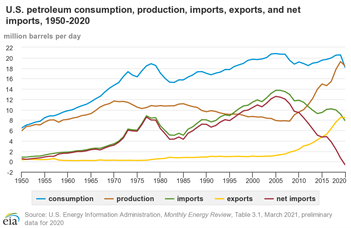
A blog of the Indo-Pacific Program
A new chapter in India-U.S. ties has unfolded nearly unnoticed amidst the COVID pandemic: Petroleum has become the cornerstone of bilateral trade. The trade of crude oil and refined petroleum products now encompasses roughly 15 percent of India-U.S. merchandise trade. The kicker? India is now the largest oil export destination for the United States.[1]
This is a rather new story. The United States only lifted its ban on crude oil exports in 2015, and India only began importing U.S. crude in October 2017, “in an effort to reduce over-reliance” on just a handful of countries. Most of India’s oil majors, including Reliance Industries Limited (RIL), Indian Oil Corp, Bharat Petroleum, and Hindustan Petroleum (HPCL), now buy copious amounts of U.S. crude of varied grades, including light ones like West Texas Intermediate, medium grades like Mars and Poseidon, and ultra-heavy grades that are harder to refine.[2]
Yet, few would have expected India to become the United States’ largest oil export destination so quickly. After all, India was the fifth-largest market for U.S. crude in 2020.
Top 10 Destinations of U.S. Crude Oil Exports, January-November 2021
Three global and domestic factors have coalesced to enable more U.S. crude oil exports to India.
First, the stringent U.S. sanctions on Venezuela’s oil sector, coupled with Mexico’s reduction in oil production and exports, has left a large gap in India’s oil imports. For the past decade, Venezuela has accounted for 10 to 12 percent of India’s total oil imports; however, U.S. sanctions brought India-Venezuela oil trade to a complete halt in October 2020. RIL, the largest Indian importer of Venezuelan oil, looked to the United States to make up for this shortfall, and bought 27 percent of U.S. crude exports to India in 2021. Additionally, the decrease in Mexican oil exports prompted India’s state-run refineries—which used to import large quantities of Mexican crude— to turn to U.S. crude in 2021. Although India’s imports of ultra-heavy Latin American crude fell from 600,000 barrels per day (bpd) in 2017 to 350,000 bpd in 2021, U.S. and Canadian exports brought the share of the Americas to nearly 20 percent of India’s total oil imports in 2021, at roughly 736,000 bpd.
Second, the U.S.-China trade war has nudged India even closer to the United States’ sphere of operations. In 2020, China was the United States’ largest oil export destination, while India stood at fifth place; in 2021, the roles have been reversed, with India taking the top spot and China going down to fifth. In 2019, the Chinese slapped import duties of 5 percent on U.S. crude and 25 percent on liquefied natural gas (LNG). Although these tariffs were cut in half by the U.S.-China “phase one” agreement in 2020, the damage was already done, and U.S. oil exports to China came crashing down in 2021. Of the $42 billion that China agreed to import of U.S. crude and refined petroleum products in 2021, barely half was met, with Chinese imports of U.S. crude falling from a high of 867,300 bpd in September 2020 to only 258,051 bpd in 2021.[3] In addition to tariffs, U.S. bans on investments in Chinese energy companies, such as China National Offshore Oil Corporation, Norinco, Sinochem, and ChemChina, have further decreased the U.S.-China energy space.
Besides these two global factors, a third domestic trend has also had an impact on India-U.S. energy trade in 2021: Indian refineries operated at nearly 100 percent capacity for much of the second half of 2021 in order to “meet growing fuel demand following the easing of lockdowns.” As the COVID pandemic pushed individuals to use more personal than public transport (to maintain social distancing and accommodate reduced public transport capacity mandates), the demand for gasoline rose rapidly—so much so that gasoline consumption reached pre-pandemic levels by mid-2021.
In addition to these three factors, there remains another element that is a constant in India’s oil trade: the Middle East. In the decade-long period of 2010 to 2020, the Middle East accounted for 62 percent of India’s total oil imports. Despite some volatility in supply, particularly from Iran (which faces strict U.S. sanctions that brought India-Iran oil trade to a standstill in 2021), the region still supplied 61 percent of India’s oil imports in 2021 thanks to steady supply from Iraq, Saudi Arabia, and the United Arab Emirates. While the Middle East will remain the chief supplier of India’s oil in the long term, more recent exporters like the United States are an important source of diversification and add an element of flexibility in terms of oil sourcing.
Surprisingly, the India-U.S. oil trade is not a one-way street: India also exports an average of roughly $3 billion worth of diesel and refined petroleum products to the United States each year. Most of these exports are from India’s private refineries, such as RIL and Nayara Energy, which account for three-fourths of India’s total refined petroleum exports.
The way forward
India’s place as the United States’ top oil export destination is not a one-time event. Oil is likely to become the mainstay of India-U.S. trade for at least the next decade. The U.S.-India Strategic Energy Partnership launched in 2018 (renewed in 2021 as the Strategic Clean Energy Partnership) and multiple long-term contracts (of up to 20 years) signed by Indian companies to source U.S. oil and gas are indicators of what’s to come. We can expect the following from India and the United States going forward:
- The United States became a net petroleum exporter—when petroleum exports exceed imports—for the first time in 2020, and this upward trend of crude exports is likely to continue, given that it reduces consumer fuel costs, increases domestic investment, and creates more jobs. About 13 percent of total U.S. crude exports were destined for India in 2021 and given India’s rising demand for fuel, the country is likely to remain amongst the top markets in the coming decades. If the U.S.-China trade war intensifies, resulting in lower U.S. crude oil exports to China, India will gain even more prominence since it is the next-largest global importer of oil. India is an enormous market for oil, so much so that a single Indian company, RIL, has more refining capacity than the Netherlands or France, both of which are amongst the top 10 destinations for U.S. crude oil exports.[4]

- India imports more than 85 percent of its petroleum needs, making energy security a key foreign policy priority for the government. The United States can become a stable, long-term supplier of oil to India, especially given its varied grades of crude oil that offer more flexibility and different pricing options for Indian oil importers The initiative by India’s oil ministry to bring together public and private oil companies to negotiate joint import deals is likely to lead to even more imports of U.S. crude, in larger quantities and at deeper discounts.
In this age of climate change and carbon neutrality, it would be remiss to ignore the negative environmental impact of petroleum and what the India-U..S. oil trade means for the future of oil and clean energy in both countries.
As India’s economy grows, the demand for energy too increases exponentially. As per the Indian government’s National Energy Policy, even if the country achieves its most ambitious forecasts for increasing the share of clean energy in India from a mere 266-terawatt hours (TWh) in 2012 to 2602 TWh in 2040, India would still need to import 7.2 million bpd of oil annually to meet its energy demands—a sizeable increase from the 4.3 million bpd of annual imports between 2016 and 2020. If the share of renewables in India’s energy matrix is unable to increase 10-fold between 2012 and 2040, India may need to import as much as 9.3 million bpd of oil each year. The import of petroleum thus remains an indispensable part of India’s near-future, whether we like it or not.
There are, however, some positive signs on the sustainability front. India’s oil companies are already planning for carbon neutrality and becoming more environmentally sustainable. RIL has set a target of achieving net carbon zero by 2035, and even state-run HPCL aims for net-zero by 2040—far sooner than India’s net-zero target of 2070. RIL has also begun sourcing “carbon-neutral” oil by partnering with companies like Oxy Low Carbon Ventures, which achieve carbon neutrality through the offset of carbon credits, direct air capture technologies (which extract CO2 directly from the atmosphere), and geological sequestration (which store CO2 in underground geologic formations for hundreds to millions of years). Additionally, the U.S.-India Strategic Clean Energy Partnership and the U.S.-India Climate Action and Finance Mobilization Dialogue will help reduce both countries’ carbon footprints and enable them to collaborate more in finding better clean energy solution. One example is the U.S. International Development Finance Corporation’s commitment to finance half a billion dollars worth of solar energy projects in India.
This increase in oil trade will add another important dimension—energy security—to an already significant and strategic India-U.S. bilateral relationship, which includes other, even more important elements—especially defense, nuclear and technology cooperation. In the larger geopolitical context, the addition of energy security to India-U.S. ties is likely to bring both countries even closer together as they intensify their common rivalry with China.
Hari Seshasayee specializes in India’s foreign policy and the political economy of Latin America. He is a trade advisor at ProColombia, a Colombian government agency, and a Global Fellow at the Woodrow Wilson Center. He can be reached at harisesh@alumni.stanford.edu and tweets at @haricito.
The views expressed are the author's alone, and do not represent the views of the U.S. Government or the Wilson Center. Copyright 2020, Asia Program. All rights reserved.
[1] The data is from the US Census Bureau (https://usatrade.census.gov/) from January to November 2021. Independent trade figures and oil tracking data for December 2021 confirm that India will remain the largest oil export destination for the United States for the 2021 calendar year.
[2] The diversity in sourcing different grades of crude oil is a sign of the long-term interest in India’s import of US crude oil. Currently, private refiners like Reliance Industries import 27 percent of the US crude that comes to India in the form of ultra-heavy crude. Another 67 percent is imported by India’s public oil companies that prefer light crude, while the remaining 6 percent is made up of medium grades.
[3] Calculations based on US Census Bureau data.
[4] RIL’s refining capacity, as per the company’s 2020-21 annual report, stands at 1.4 million bpd. As per the BP Statistical Review of World Energy 2021, both France and the Netherlands have a refining capacity of 1.2 million bpd.
Author

Advisor to the Foreign Minister of Panama and Asia-Latin America Expert, UNDP

Indo-Pacific Program
The Indo-Pacific Program promotes policy debate and intellectual discussions on US interests in the Asia-Pacific as well as political, economic, security, and social issues relating to the world’s most populous and economically dynamic region. Read more





